Mankell Family History
Maps of ancestral homes in Norway
Sven Gunderson Borgen (1810-1904)
and Margit (Syvertsdatter) Borgen (1812-1891)
Sven Gunderson Borgen homestead documents. Sven was also known as Swen Gunderson.
For more biographical information (including 1862 Dakota War) read the extensive obituaries of Gunder and Gemine Swenson.
Main sections in the Borgen webpage:
- Sven Gunderson Borgen (1810-1904) and Margit (Syvertsdatter) Borgen (1812-1891)
- Norway
- Borgen-Swenson Farm, Kandiyohi County, Minnesota
- Indian Outbreak (Dakota War) of 1862
- Three views of the Isle of Refuge
- Articles about Dakota War
- 150th Commemoration
- Homestead
- Sven Borgen's 93rd birthday
- Deaths of Sven and Margit Borgen
- Ragnild Engen, daughter
Sven Gunderson Borgen (1810-1904) and Margit (Syvertsdatter) Borgen (1812-1891):
Children of Sven and Margit:
- Ragnild (1839-1903) married Christoffer/Christopher Hanson Engen, 1861
- Bergetta/Bergit (1840-1927) married Thomas Osmundson
- Gunder (1845-1934) married Gemine Negaard
Immigrants Sven and Margit Gunderson Borgen and their three children arrived in the US from Numedal Norway in April 1857, having sailed across the ocean. Ragnild was 18; Bergit was 16; Gunder as 12 years old. By compiling information from Dick Lindahl's book and information on the website norwayheritage.com, it looks like the sailing ship was named Balder, with Captain G.A. Haagensen at the helm. The sailing ship was a "Bark" class of ship which left the freshwater port of Drammen, Norway (southwest of Oslo in Buskerud County) in early May, 1857 with 220 Norwegian emigrants and arrived in Quebec Canada on June 26, 1857. After arriving in Quebec the family then traveled to Rock County, Wisconsin. Sven and his family settled in the same area as his two brothers Syver and Steen Gunderson who had sailed to the US and settled in Rock County in 1842. (Norwegian settlements near Beloit in Rock County Wisconsin date back to 1839.) While at Rock Island, younger daughter, Bergit married Thomas Osmundson in 1857.

Drawing of a Bark sailing ship, with three masts.
Emigrants traveled from Norway across the ocean on a journey lasting 5-6 weeks.
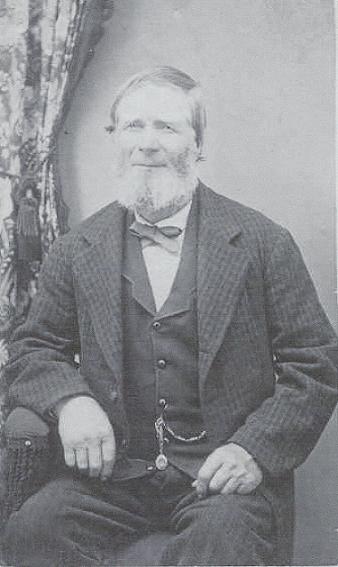
Sven Gunderson Borgen, father of Gunder Swenson and grandfather of Minnie Swenson, was born
in Numedal Valley in Norway. Sven's wife Margit Syvertsdatter was born in Hallingdal Valley in Norway (see maps). Their three children were born in Numedal, Norway.
Norway:
The following four pictures are from the Borgen farm, located in Numedal Valley in Norway. Thanks to Patricia Medhus for these photos which she took on a recent trip to Norway. As you look at the furniture pictures, please take note of the log walls of the house and the beautiful rosemalling on the furniture.
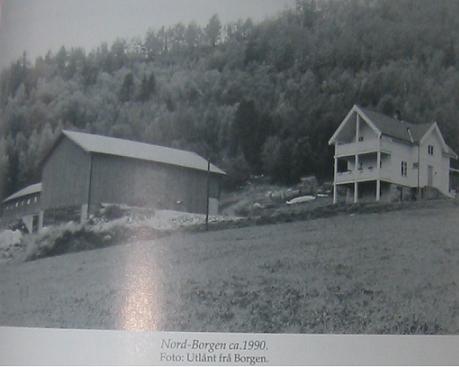
The Borgen farm, c1990, in Numedal Valley, Norway.

A hutch.
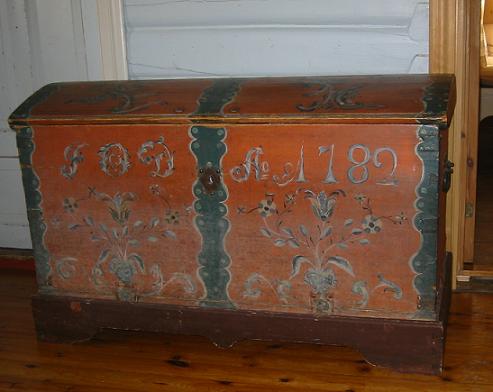
A 1782 trunk.
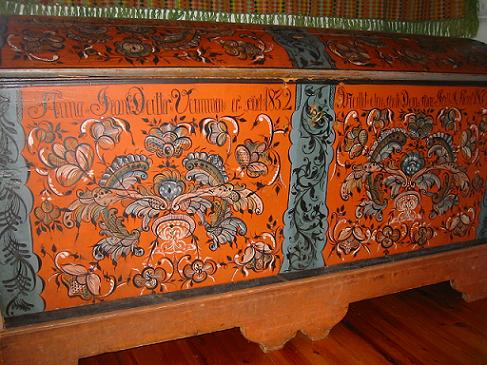
An 1832 trunk.
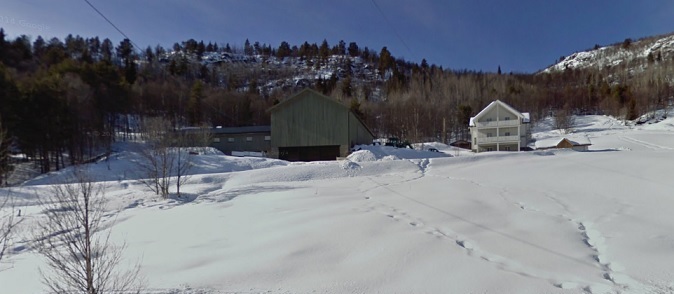
Borgen Farm, Numedal Norway, in 2010.
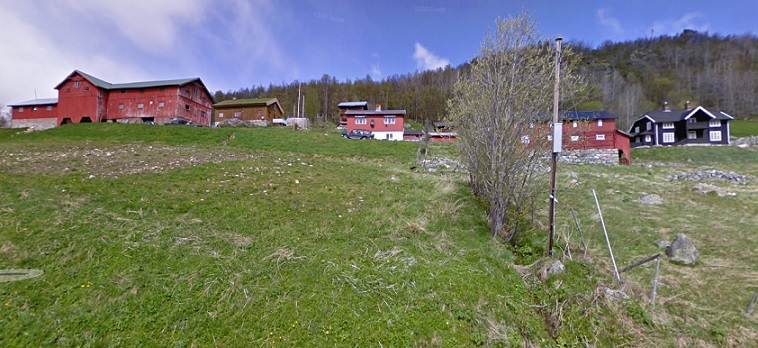
Aasberg farm, Numedal Norway, in 2009. Home of Sven Borgen's mother, Ragnild Asbjornsdatter
Borgen-Swenson Farm:
According to local historian Gabriel Stene, Sven's daughter Bergit, her husband Thomas Osmundson and son Samuel, left Rock County, Wisconsin, in 1859 to travel to the Norway Lake settlement in Monongalia County (later merged with Kandiyohi County), Minnesota. The Osmundsons traveled with other pioneers would make Norway Lake home: Johannes Iverson and family, Hans Peterson, Nels Peterson. Thomas wrote to his father-in-law telling him of the "fine country, and of the water, fish, deer, muskrats and an abundance of game and good soil; that the land was to be had free, but if he intended to avail himself o the opportunities, to come at once, as the land went fast."
About a year later (either 1859 or 1860) Sven, Margit and their two children traveled 400 miles northwest to Norway Lake, Monongalia County (later Kandiyohi) settling south of Lake Mary where the family took a pre-emption claim, under the Pre-emption Act of 1841, in section 24 of present Arctander Township. They drove an oxen team and also brought one cow and a calf on this journey over poor roads or no roads at all, going around swamps and hills. They settled and farmed an area south of what would later be known as Jericho and before the first congregation was organized in 1868.
According to a biography of Gunder Swenson in the 1905 History of Kandiyohi County, they arrived during the summer of 1860 so there was no farming during those first months. They fished in nearby lakes and hunted prevalent game. They used a coffee mill to grind corn for bread. The first spring they plowed some land and planted wheat, corn and potatoes. Daughter Ragnhild went to St. Cloud to look for work; she married Christopher Engen in St. Cloud on May 11, 1861. They then settled on his farm, which Engen claimed in 1859 under the Pre-emption act of 1841. In 1863 Borgen applied witht he US government for this farm to become a homestead farm . The Ragnild and Christopher Engen farm was located to the west of Norway Lake. Sven Borgen, Thomas Osmundson and Christopher Engen built the log cabin for the Borgen family.
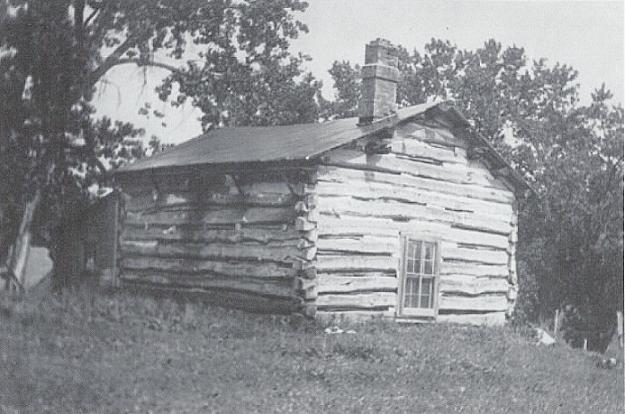
This cabin is the first home built (1859 or 1860) by Norwegian immigrants, Sven Gunderson Borgen, his wife Margit Borgen and two (Gunder, Ragnhild) of their three children on their homestead farm between Lake Mary and Swenson Lake on the eastern edge of Arctander Township, Kandiyohi County, Minnesota.
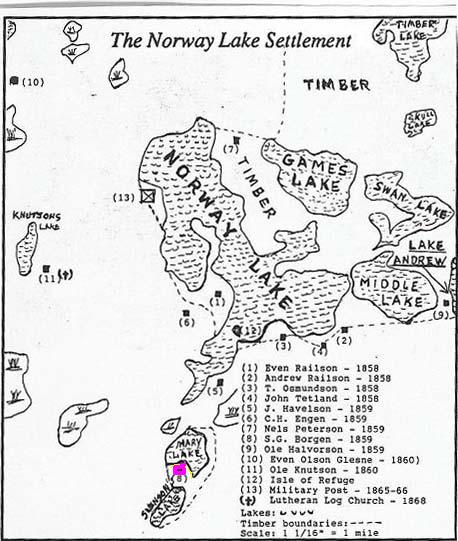
Location of the Borgen/Swenson farm (#8 on map) which was part of the original Norway Lake Settlement.
The Engen farm is #6 on the map.
(PDF of larger map)
In the summer 1860, when he was 15 years old, Gunder left the farm and went east to Acton Township in Meeker County where he was hired to a farmer, Robinson Jones. Gunder built a rail fence and plowed the fields at a rate of $5 a month. He worked for Jones for a month and half until he realized that Jones did not have the money to pay him. Rather, Jones paid him with 15 bushels of wheat. (Two years later Jones was killed by Indians at the fence which Gunder built; Jones one of the first victims of the Dakota War in Minnesota.) There is more information about this story in Gunder's obituary.
Another story about Gunder involves borrowed dishes and sheep. The Borgen family was expecting threshers at their homestead. To feed many men Margit Borgen needed more dishes than what she had in her home. So she sent Gunder to the neighbor, Andrew Hedin, to borrow some. Gunder walked on the west side of Lake Mary, through Hedin's pasture to get to the neighbor's home. But this pasture had a ram known for head-butting . As Gunder returned home with the borrowed dishes tied up in a cloth he saw the ram and the ram saw Gunder. Gunder set down his bundle of dishes and as the ram charged Gunder side-stepped and then threw himself up and onto the ram. Gunder then managed to lift the front legs of the animal and laid them over the ram's spiral horns. The helpless ram was unable to lift his legs out of this unusual position. Gunder then picked up the sack of dishes and walked home. He returned a few minutes later and released the ram.
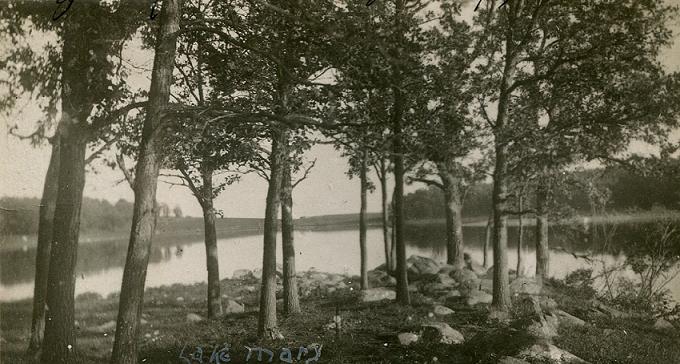
Lake Mary, looking north.
Indian Outbreak (Dakota War) of 1862
In August of 1862 the Norway Lake settlers received warnings that the Dakota Sioux in the area had killed Swedish settlers in the Monson Lake area to the west. Son Gunder, age 17, was not at home so he took refuge at the Knutson cabin north of the Borgen farm. (The Knutson cabin was rebuilt and is now part of the Norway Lake Lutheran Historical Association) When Gunder arrived at the cabin he found it full of men who had gathered there after searching for survivors at the Monson Lake settlement. Gunder stayed at the Knutson cabin overnight and the next morning he started for home. Along his route he learned that his family had already gone to the island near the southern shore of Norway Lake where many settlers had taken refuge. (The island later became known as the Isle of Refuge.)
A group of men decided to go to Monson Lake and bury the dead. Young Gunder joined the group. When the men had reached the Lundborg cabin at the settlement, Gunder, with his horse, was sent ahead to scout if any Indians were nearby. There were no Indians, so the group buried the dead while Gunder remained on guard.
Very few settlers remained in the area after this outbreak--what was later called the 1862 Sioux Uprising or the Dakota War. The Borgen family went to Rice Creek, near Minneapolis, and remained there for 3 years, then returned to their farm in 1864.
In May, 1863, Borgen applied in Ramsey County Court to receive a Depredation Claim for his destroyed and lost personal property: farm buildings, crops, animals,and fencing. Son-in-law Thomas Osmundson was his witness. He applied under the name "Svend Gunderson" not Borgen. Claim #2122 was accepted and Borgen received $166.00 in October 1863. In the application documents, Borgen stated that he had
lived there 2 years before the outbreak, had a farm then owned at that time all the property...It was all destroyed during the outbreak...On 21st August 1862 on account of outbreak I left my home and all the property...The stable was 40 x 12 built of logs, was worth $23. I had 12 tons of hay in the stack, had 5 acres of wheat, 15 bushels rye, 1 acre of potatoes, 2 bushels beans, 1 acre corn, nearly 1 acre rutabagas. My garden was lost. I had 1 year hog and 5 spring pigs, had 8 hens, lost 200 rails [his fence]. They are burnt. The windows were broken in my house.Gunder's obituary contains more information about the family during the time of the Dakota War, a map of events in Acton MN, and more information about the fence Gunder built for Robinson Jones in Acton.
Three views of the Isle of Refuge:
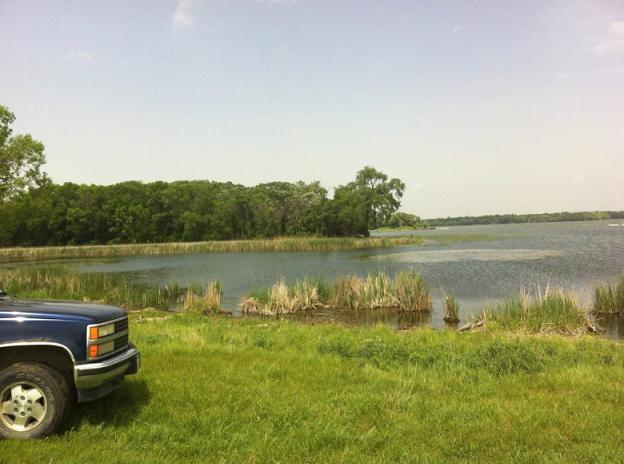
Isle of Refuge, 2012.
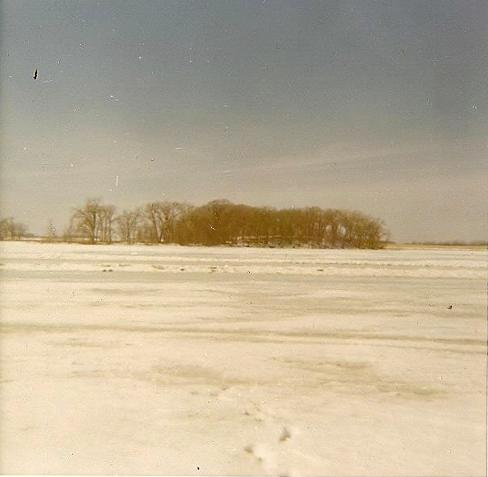
Winter view of the Isle of Refuge, 1974.
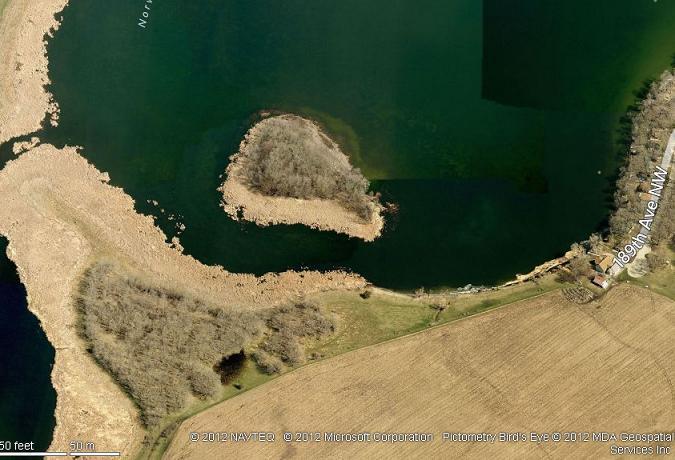
Aerial view of the Isle of Refuge, 2012.
Articles about Dakota War:
In 1914, Rev. Daniel C. Jordahl (1864-1947) wrote about the Norway Lake settlers, the Lundberg and Broberg families of Monson Lake, the Isle of Refuge, and events of August 1862 in an article published in "SYMRA". (DC Jordahl uses colorful language of the day which modern sensibilities may find a bit harsh.)
Kandiyohi County historian and Norwegian settler, Gabriel Stene, wrote an article about the settlers leaving the Isle of Refuge to travel east to safety, with their cattle:
After burying the thirteen victims at New Sweden (Monson Lake), and after (Thomas) Osmundson had trimmed the grave of his mother which was near the island, they spent the second night on the island. They dared take no more chances and on the following day, with a few loaded wagons drawn by oxen, they left for Paynesville and St. Cloud, driving their cattle before them.
Among those in the caravan were the mother and five children who had left the husband and father dead, and who had seen the girl, Mary, carried off on the back of an Indian pony. The mother was sad, but thankful that she had five of her children with her on the trail to safety. (note: This mother was the widow of Johannes Iverson.)
Arriving at St. Cloud after three days, they found only a ferry across the river, as there had been no bridge built at that time. The St. Cloud people refused to ferry them over, but told them to bunch up and they would be safe.
Mary Iverson, who had been carried off by the Indians and had escaped, had arrived at St. Cloud previous to the arrival of the caravan, and there joined her mother.
That same day a company of one hundred men on horseback buried Iverson's body. These men were all from St. Cloud...When the St. Cloud people refused to ferry the caravan across the river, Thomas Osmundson, Sven Borgen, Gunder Swenson and others with a little fighting blood decided to fight it out with the St. Cloud bunch rather than take chances with the Indians, but, the St. Cloud bunch gave in and ferried across everything but the cattle.
Three men were left with the cattle, and Osmundson, who had an ox which he had broken to ride, decide to swim the cattle across. He finally coaxed the ox into the water, and the rest of the stock followed. The caravan then proceeded to St. Anthony Falls, where they separated. Mrs. Iverson and children went with the Railsons and a few others to Rice County. Hans and Nels Peterson volunteered to go and fight Indians.
Sven Borgen and wife and son, Gunder, C(Christopher) Engen and wife (Ragnhild), and Osmundsons went up Rice Creek to Mahnomen where they found a little saw mill and a few cabins which had been deserted. Here they decided to remain over the winter, 12 miles east of Anoka, also known as Fridley Station. It was pretty late in the year to get winter feed for the stock, but a farmer up the river told them they could have all the grass they wanted from a marsh he owned, for 25 cents a load. Borgen and son, Gunder, each purchased a scythe and went to work, taking care not to step into water holes....
In 1864 Andrew Railson from Rice County hunted up Osmundsons and asked them to go back to the Norway Lake country and put up hay, with the intention of spending the winter there. Upon arriving there (Norway Lake) they found the country going through a terrible draught. Prairie fires in July had left the ground full of cracks wide enough to put your fist in. The so-called Norway Lake slough was so dry you could cross it any place with a team. there was no hay to be had and they had to return to the colony for another winter.
In 1865 the entire colony went to Norway Lake. Fires had ruined everything. Cabins and stables had to be built anew. The only cabins now standing are those of Eric Kapperud and Swenson's and Broberg cabin. The entire colony united in making dugouts and shacks, and log stables and dugouts for the cattle.
They were all husky men and because of the open winter they could work in their shirt sleeves until February. The men worked in a gang, one job at a time. They started at Andrew Railson's, and then went to Osmundson's Halvorson's, Borgen's, Engen's, Even Railson's, Eric Kapperud's, Ole Knutson's, Even Glesne's, Lars Iverson's and Helge Hillerud's. They were all done when the snow came in February.
Gabriel Stene wrote about an event at Monson Lake State Park (Swift County) held on August 17, 1930, 68 years after the settlers were killed. Gunder Swenson, by this time blind and almost deaf, was at this event. Stene writes:
I escorted my blind friend, Gunder Swenson, to the platform at the Monson Lake gathering, where the good people have provided a rocking chair for him. Mr. Swenson and myself have been neighbors and friends for 63 years. He has not only the affliction of being blind (three years now) but he is also very hard of hearing. "I can hear the voices, but the songs and music, but I cannot distinguish a single word or tune"....Mr. Swenson entertained many listeners with his early pioneer stories. He was a lad of 17, who was placed upon a horse as a lookout watching for any approaching redskins while the survivors were digging the grave large enough for the 13 massacred persons at this place. He is now 85 years old and blind but is the only one left who can tell the story of the rescuing of refugees and bringing them to the Isle of Refuge. Of the hurried flight, sleeping in the open, and fear of being surprised by the savages. With his nephew, then four months old, and Mrs. John Skare, then one year old, these three are the only ones left of the forty-three who were rescued and remained on the Isle of Refuge three nights--August 20, 21, and 22, 1862.
Orlynn Mankell wrote several articles about this time period, including how the Borgen family were affected by the Sioux Uprising of 1862, the drought of 1963-1864, and their return to their cabin along Lake Mary in the fall of 1864. In another article Orlynn writes about the killing of Lonely Gravestone Tells of Pioneer's Fate: Johannes Iverson, and how the family found themselves separated with three children seeking shelter at the Borgen cabin.
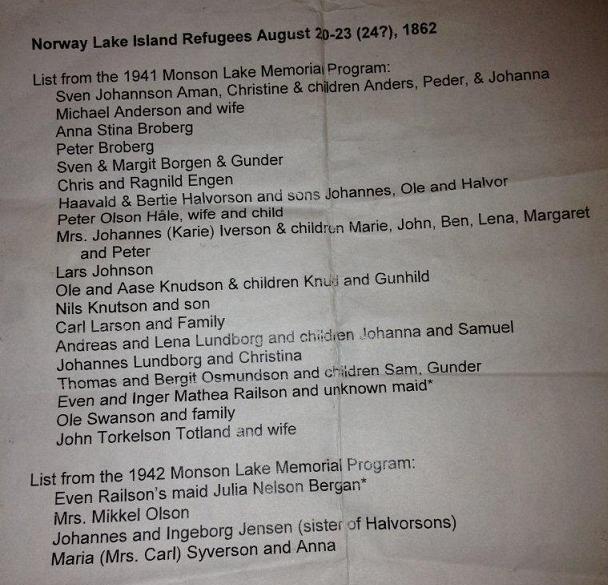
List of people who took refuge on the island, August 20-23, 1862.
Swenson ancestors who took refuge on the island: Sven & Margit Borgen and Gunder;
Chris and Ragnild Engen; Thomas and Bergit Osmundson and children Sam, Gunder;
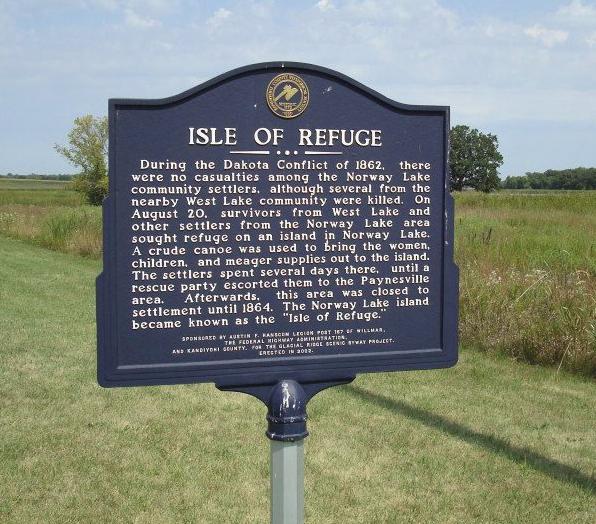
Historical Marker
150th Commemoration
On August 20, 2012, three descendants of the Borgen and Swenson families canoed to the Isle of Refuge. Kurt Mankell, Grady Larimer and Bill Larimer camped on the island for 2 nights to commemorate the 150th anniversary of the Dakota War and to honor the memory of their ancestors who stayed on the island 150 years ago, worried for their safety, families, friends, farms, and future.
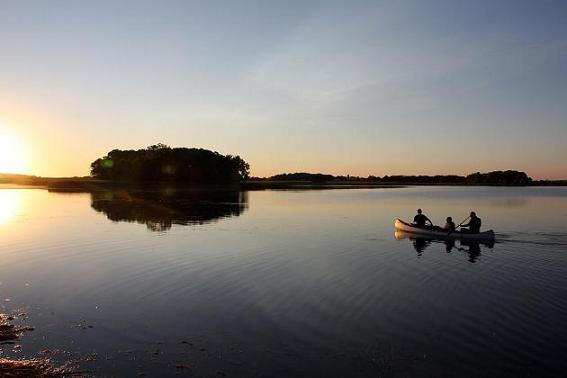
Taking the canoe to the Isle of Refuge, August 2012.
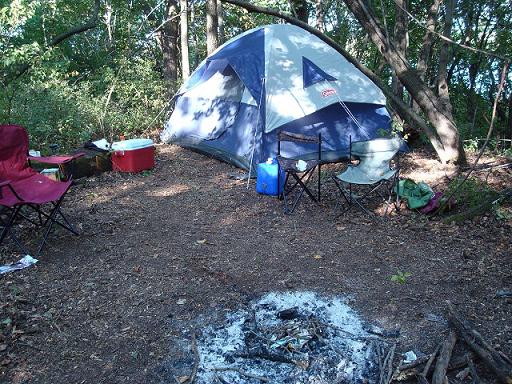
Camping on Isle of Refuge, August 2012.
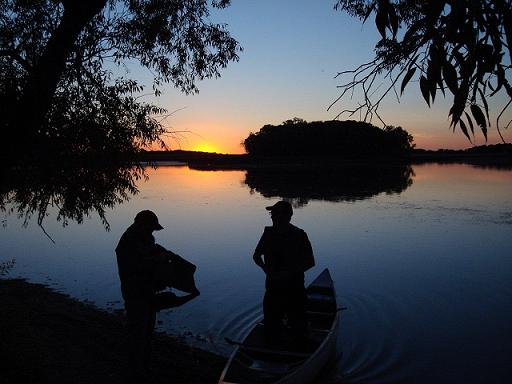
Sunset at Isle of Refuge, August 2012.
Homestead
In December, 1863, after his short visit to his farm and before the family returned in 1864, Sven Borgen applied for a homestead with the US government at the Land Office in St. Cloud. This Swenson homestead was the same location as his pre-emption claim, Section 24 of what was later called Arctander Township. When Sven, Margit and Gunder returned in 1864, they returned as homesteaders, ready to live on and develop the farm as required by the Homestead Act of 1862. He received the final certificate of ownership, dated 1869.
In March 1870 a legal contract was drawn by the Register of Deeds where Gunder Swenson agreed to take care of his parents Sven and Margit Gunderson Borgen, providing food and shelter during his parents' advancing years:
"that on or before the first day of December, each and every year, [Gunder] shall deliver to [Sven and Margit] eighty bushels of wheat, twenty bushels of potatoes, two hundred pounds of pork all of good quality, also six pounds tobacco, six pounds of coffee, six pounds of sugar, and one half a barrel of salt and one half a gallon of alcohol....to furnish a sufficient good room as a living house and fuel..."Some of that tobacco was for Margit, because she smoked a corncob pipe, according to her great-granddaughter, Helga Swenson Lindahl.
Sven Borgen's 93rd birthday:
The Willmar Tribune published an article about Sven Gunderson Borgen celebrating his 93rd birthday in July 1903:
Last Thursday in the town of Norway Lake, Swen Gunderson celebrated his ninety-third anniversary of his birthday, and the occasion was the gathering of a large number of relatives besides many other invited guests. The aged gentleman makes his home with his son, Gunder Swenson, and the family had planned to make this observance of his birthday one in which all the relatives in the county could be present and make it a pleasant reunion. All the families represented in the relationship included a total of 51 persons and in addition to these there were neighbors and friends that swelled the number of guests present on the occasion to 75. The grandchildren and families who were present from this city were the following: Samuel, Gunder and Sivert Osmundson, Mrs. A. O. Qvale, Mrs. Hendrick Johnson and Mrs. John Noren.
Mr. Gunderson is said to be quite active for his age and may yet reach the date when he can celebrate his 100th birthday. He is an early resident of the ocunty, coming here before the Indian outbreak, and has many reminiscences of the pioneer life to relate.
It is needless to say that the old gentleman enjoyed Thursday's celebration fully as much as his children, grand children and great grand children as well as other relatives present.
Deaths of Sven and Margit Borgen:
Margit (Syvertsdatter) Borgen died on July 26, 1891. The Willmar Republican Gazette published her obituary on August 6, 1891:
Mrs. Swen Gunderson, one of our oldest settlers, passed away Thursday evening of last week. Funeral [was] last Sunday afternoon, which was one of the largest ever witnessed here. There were twenty-four well-filled conveyances that accompanied the remains to their last resting place. Rev. R. K. Fjelstad performed the ceremonies. The deceased was nearly 80 years old, and leaves an aged husband and three children: Mrs. C. H. Engen and Gunder Swenson of this town [Norway Lake] and Mrs. Thomas Osmundson of Willmar, who, with her large family, attended the funeral together with Judge and Mrs. C. E. Lien.
Sven Gunderson Borgen died in 1904. His obituary was in the Willmar Tribune, November 30, 1904, "Death of a Pioneer Resident":
At the ripe old age of 94 years, Swen Gunderson Borgen, of the town of Arctander, passed away last Sunday at the house of his son, Gunder Swenson. Death was due to a general breaking up of the vital forces.
The deceased at the time of death was perhaps the oldest inhabitant of the county. He was among the earliest settlers of the town of Arctander, having resided in the county since 1860, and had seen much of the privations of pioneer life. Besides his son, a daugther, Mrs. Thomas Osmundson, of Fentress, Va., survives him.
The funeral will take place on Saturday at 10 o'clock a.m., from the late home in Arctander. Rev. Sotendahl of the United Lutheran church will preach the funeral sermon and conduct the final obsequies at the Lutheran cemetery.
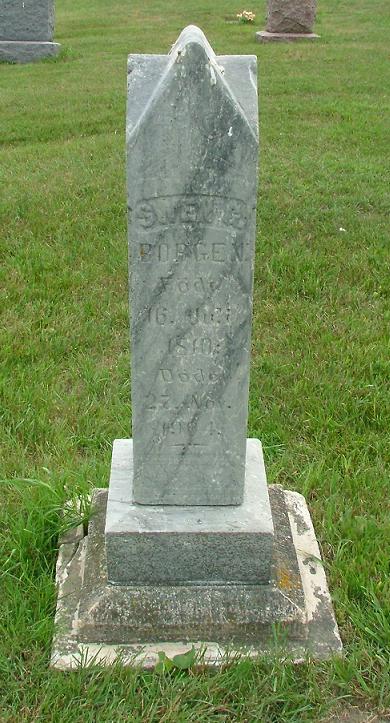
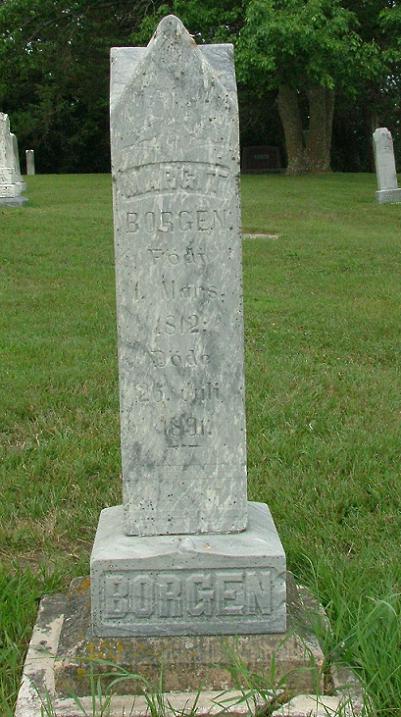
at East Norway Lake Lutheran Church. One grave stone with Margit's name facing east and Sven, west.
Ragnild Engen, daughter
Obituary of Ragnild Engen (1839-1903) from the Willmar Tribune, December 9, 1903, "Death of a Pioneer Lady":
On Wednesday of last week, Dec. 4, Mrs. Raghnild [sic] Engen, wife of Christopher Hansen Engen, one of the early pioneers of Arctander, passed away. She had suffered a lingering illness and during the last few weeks required constant nursing, hence death came as a relief. The deceased was born at Numedal, Norway, in 1839, and hence reached the age of 64 years. She was a daughter of Swen Gunderson, who survives her, being nearly 96 years of age. The deceased was a sister of Gunder Swenson.
Her family arrived to the Norway Lake country in 1860. Here she met her future husband, who had arrived the previous year. They were married at St. Cloud May 11, 1861, one of the very early marriages in the county. The following year they had to leave their newly-founded home on account of the Indian out break, and resided for some time at Zumbrota in Goodhue county. The deceased was a devout member of the Norway Lake Hauge's church [Nannestad Lutheran Church], and the funeral occurred at that churchyard on Tuesday of this week, Rev. J. S. Halverson of Spicer officiating. Peace to the ashes of the brave pioneer woman, who shared with her husband the trials and hardships of the early settlement.
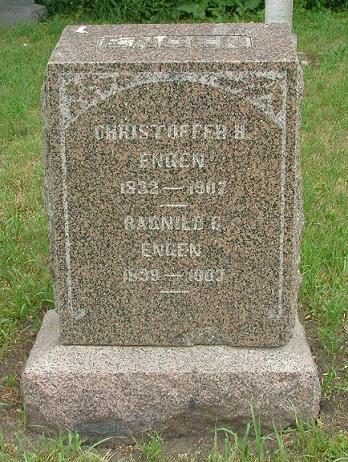
The graves of Sven and Margit's daughter Ragnild and her husband Christopher Engen, part of the
Norway Lake Settlement (no. 6 on above map), are at the Nannestad Cemetery,
one mile west of East Norway Lake Lutheran Church in Jericho. No church remains at this site.